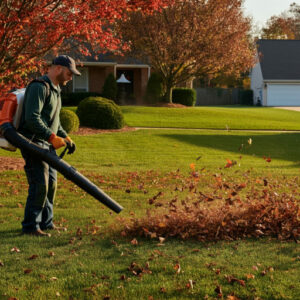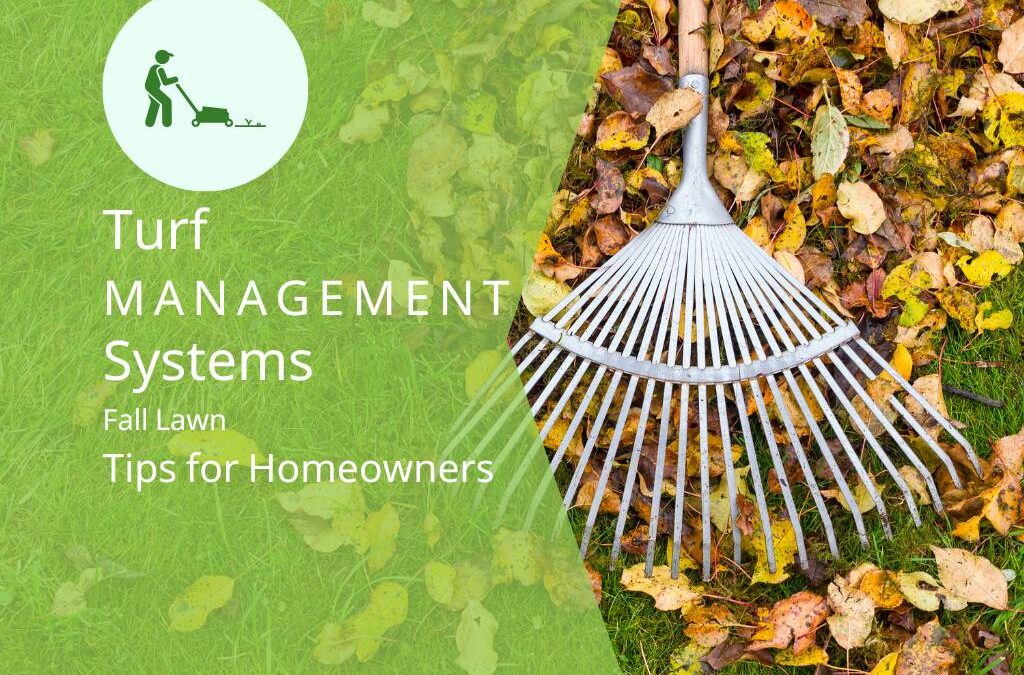As the leaves begin their colorful transformation across Birmingham and the morning air carries that crisp hint of autumn, I find myself reflecting on the countless lawns I’ve helped transform over my years in the turf management industry. Fall is one of my favorite seasons for lawn care—not just because the weather becomes more comfortable for working outdoors, but because this is when we can set our lawns up for success through the winter and into the following spring.
I’m Chris Sheedy, and I’ve been passionate about creating beautiful outdoor spaces here in Birmingham for years. Through Turf Management Systems, I’ve learned that fall lawn care isn’t just about raking leaves—it’s about preparing your lawn for the challenges ahead while addressing the wear and tear from our hot Alabama summers.
Let me share the strategies that have helped my clients achieve the healthiest, most resilient lawns in neighborhoods from Mountain Brook to Vestavia Hills.

Understanding Birmingham’s Unique Fall Challenges
Living in central Alabama, we face specific challenges that many other regions don’t experience. Our warm-season grasses like Bermudagrass and Zoysia are beginning their transition into dormancy, but we still have weeks of active growth ahead. Meanwhile, cool-season weeds are just getting started, taking advantage of the cooler nights and morning dew.
I’ve watched homeowners struggle with these competing demands year after year. The key is timing your efforts precisely with our local climate patterns.
The Weed Window
September and early October represent what I call the “weed window” in Birmingham. This is when winter annuals like henbit, chickweed, and annual bluegrass begin germinating. Once established, these weeds will dominate your lawn through winter and into spring.
I always tell my clients: the battle against winter weeds isn’t fought in January—it’s won or lost in September.
My Essential Fall Lawn Care Strategy
Over the years, I’ve developed a systematic approach that addresses the specific needs of Birmingham-area lawns during autumn. Here’s my step-by-step process:

Step 1: Pre-Emergent Herbicide Application
The single most important task for fall lawn care in our area is applying pre-emergent herbicide. I recommend applying it between mid-September and early October, before soil temperatures consistently drop below 70°F.
For my clients, I typically use products containing prodiamine or pendimethalin. These create a chemical barrier in the soil that prevents weed seeds from germinating without harming established grass.
Pro tip from my experience: Water the application in with about half an inch of irrigation within 24 hours. This helps activate the herbicide and prevents it from breaking down in our still-warm September sun.
Step 2: Adjust Your Mowing Height
As warm-season grasses prepare for dormancy, I adjust mowing heights gradually. For Bermudagrass, I start lowering the cut from summer heights of 2-3 inches down to about 1.5-2 inches by late October. This helps prevent snow mold and other fungal issues if we get an unexpected cold snap.
However, I never remove more than one-third of the blade height in a single mowing. This rule has saved countless lawns from stress damage over my career.
Step 3: Fall Fertilization Strategy
Many homeowners ask me about fertilizing in fall, and my answer depends on the grass type. For warm-season grasses like Bermudagrass, I apply a final feeding in early September with a balanced fertilizer that’s slightly higher in potassium. This helps strengthen the grass for winter dormancy.
I avoid high-nitrogen fertilizers after mid-September. Pushing new growth this late in the season makes grass more susceptible to cold damage and disease.
![]()
Addressing Soil Compaction
After a summer of foot traffic, play, and our infamous Alabama clay soil, fall is the perfect time to address compaction. I’ve seen dramatic improvements in lawns simply by aerating in October.
For most Birmingham-area lawns, I recommend core aeration using a machine that pulls actual plugs of soil rather than just poking holes. This relieves compaction and allows air, water, and nutrients to penetrate the root zone more effectively.
Signs Your Lawn Needs Aeration
During my property assessments, I look for these telltale signs:
- Water runs off the surface rather than soaking in
- Grass appears thin despite adequate watering and fertilization
- Hard, compacted soil that’s difficult to penetrate with a screwdriver
- Areas where foot traffic has created worn paths
Leaf Management Strategy
Birmingham’s beautiful fall foliage creates a management challenge that I help clients navigate every year. While a light layer of leaves can actually benefit your lawn by providing natural organic matter, thick layers block sunlight and can harbor diseases.
My approach is practical: rake or mulch leaves weekly rather than waiting for them all to fall. For smaller amounts, I often recommend using a mulching mower to chop leaves into small pieces that decompose quickly and feed the soil.

When Professional Help Makes Sense
I’ve found that homeowners often underestimate the time commitment of proper leaf removal. If you have large trees or limited time, professional leaf removal services can ensure the job is done thoroughly without damaging your grass.
Preparing for Winter Weather
Birmingham’s winters are relatively mild, but we can still experience ice storms, occasional snow, and prolonged cold snaps that stress warm-season grasses.
Final Mowing Preparation
By late November, I make sure warm-season grasses receive their final cut of the season. I lower the height to about 1-2 inches for Bermudagrass and Zoysia. This prevents matting under snow or ice and reduces the likelihood of fungal diseases.
Irrigation System Winterization
Don’t forget about your irrigation system. Even though our winters are mild, pipes can still freeze during cold snaps. I recommend having your system blown out and winterized by Thanksgiving to prevent costly repairs come spring.
Environmentally Friendly Solutions
Sustainability has become increasingly important to my clients, and I’ve adapted my practices accordingly. Here are some eco-friendly approaches that work well in our climate:
Organic Pre-Emergent Options
Corn gluten meal can serve as a natural pre-emergent herbicide, though it requires precise timing and isn’t as reliable as synthetic options. I typically recommend it for clients with small areas or those committed to completely organic approaches.
Composting Leaves
Rather than bagging all those fall leaves, consider composting them. Birmingham’s warm fall weather helps decomposition, and you’ll have rich compost for spring garden projects.
Native Plant Integration
I often suggest incorporating native plants into landscape areas to reduce overall lawn maintenance needs. Plants like native sedges and wildflowers require less water and care than traditional turf grass.

Tools and Products That Make a Difference
After years of testing different equipment and products, I’ve identified several that consistently deliver results for Birmingham homeowners:
Essential Tools
- Quality spreader: For even herbicide and fertilizer distribution
- Sharp mower blades: Clean cuts prevent disease entry points
- Soil thermometer: To time pre-emergent applications accurately
- Rain gauge: To monitor natural precipitation and adjust irrigation
Recommended Products
- Prodiamine-based pre-emergent: Excellent weed control for our climate
- Slow-release potassium fertilizer: Strengthens grass for winter
- Organic soil amendments: Compost or aged manure to improve soil structure
Common Mistakes I See Every Fall
In my years of service, I’ve noticed certain mistakes that Birmingham homeowners make repeatedly:
Mistake 1: Waiting Too Long for Pre-Emergent
By the time you see winter weeds germinating, it’s too late for pre-emergent herbicide to work effectively.
Mistake 2: Over-Fertilizing Late in Season
High nitrogen in late fall can stimulate growth that’s vulnerable to cold damage.
Mistake 3: Ignoring Irrigation Needs
Just because temperatures are cooler doesn’t mean your lawn doesn’t need water, especially during our typical fall dry spells.
Mistake 4: Scalping the Lawn
Cutting grass too short going into winter removes its natural protection against cold stress.
The Investment in Professional Care
While many fall tasks can be handled by dedicated homeowners, I’ve seen the value that professional care provides, especially for busy families or those with large properties.
Professional services ensure proper timing, correct product application rates, and comprehensive care that sets your lawn up for success. We handle everything from precise pre-emergent timing to proper equipment maintenance, allowing you to enjoy your outdoor space rather than constantly working on it.
Looking Ahead to Spring Success
The work we do this fall directly impacts next year’s lawn performance. Clients who follow proper fall care protocols consistently have healthier, more attractive lawns come spring. They spend less time fighting weeds and more time enjoying their outdoor spaces.
Remember, lawn care is a marathon, not a sprint. Each season’s efforts build upon the previous season’s work, creating a cumulative effect that results in the lush, healthy lawn you envision.
As we move through this fall season, I encourage you to view each task not as a chore, but as an investment in your property’s beauty and value. The Birmingham area offers us so many opportunities to create outstanding outdoor spaces—spaces where families gather, children play, and memories are made.
Whether you tackle these projects yourself or partner with professionals like us at Turf Management Systems, the key is taking action while the timing is right. Your lawn will thank you come spring, and you’ll have the satisfaction of knowing you’ve given your outdoor space the care it deserves.
Take that first step today. Your future self—and your lawn—will appreciate the effort you invest this fall.



Recent Comments